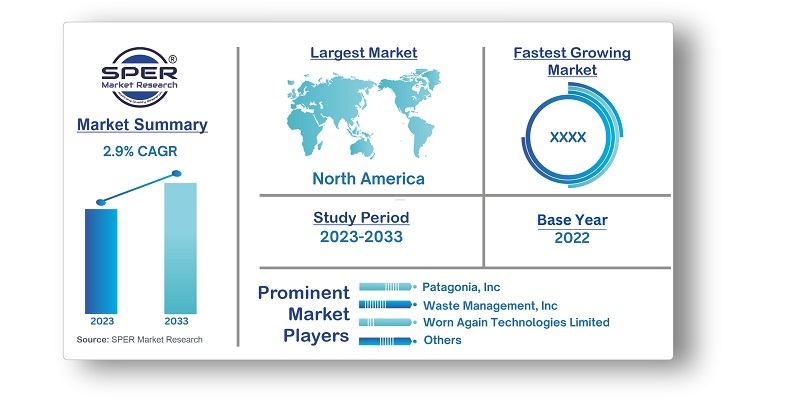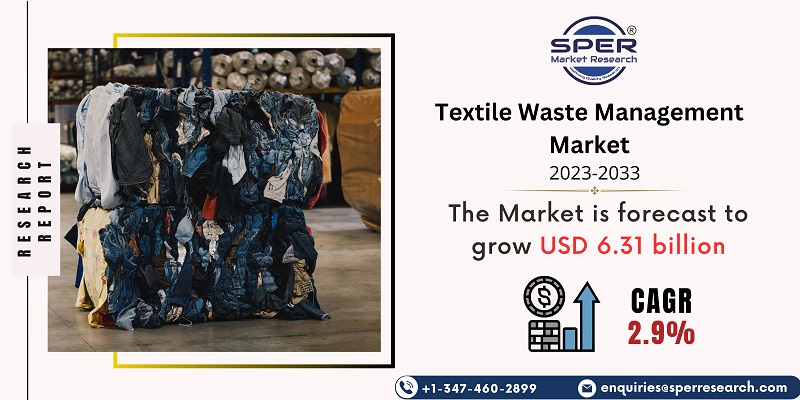
Textile Waste Management Market Growth, Size, Trends, Revenue, Challenges and Future Outlook
Textile Waste Management Market Size- By Waste, By Service, By End User- Regional Outlook, Competitive Strategies and Segment Forecast to 2033
| Published: Aug-2023 | Report ID: CHEM2382 | Pages: 1 - 230 | Formats*: |
| Category : Chemical & Materials | |||
- January 2023: Swedish firm Re: New Cell has shipped the inaugural shipment of dissolving pulp from its recently established Renewcell 1 factory in Sundsvall, located approximately 230 miles north of Stockholm. The delivery marks progress towards the facility's ultimate annual capacity goal of 60,000 tons.
- November 2022: Swedish company Renewcell has established a fresh collaborative venture with Eastman, a prominent American producer of cellulosic acetate fibers. Their partnership aims to create Naia Renew ES yarns utilizing Circulos, a 100% recycled textile raw material. This marks Renewcell's inaugural collaboration with a US fiber producer and a significant stride towards introducing acetate products utilizing Circulose feedstock.

- Adoption of Blockchain Technology: Integration of blockchain technology into textile waste management can elevate traceability, transparency, and confidence in recycling, thereby generating novel market prospects.
- Integration of AI and IoT: Incorporating artificial intelligence (AI) and the Internet of Things (IoT) can enhance waste collection, sorting, and recycling processes, leading to enhanced operational efficiency and cost reduction.
- Complex Recycling Processes: The intricacies of textile waste recycling, particularly with mixed materials and blended fabrics, present difficulties and elevate recycling expenses.
- Lack of Infrastructure: Inadequate recycling infrastructure, particularly in developing areas, obstructs the effective handling and recycling of textile waste.

| Report Metric | Details |
| Market size available for years | 2019-2033 |
| Base year considered | 2022 |
| Forecast period | 2023-2033 |
| Segments covered | By Waste, By Service, By End User |
| Regions covered | North America, Asia-Pacific, Latin America, Middle East & Africa and Europe. |
| Companies Covered | Evrnu, Inc., Genomatica, Inc., I:CO – I:Collect AG, Patagonia, Inc., Recover Textile Systems, Renewcell AB, TerraCycle, Inc., Veolia Environnement S.A., Waste Management, Inc., Worn Again Technologies Limited, Others |
- Circular Economy Advocates
- Consumers and Individuals
- Eco-Friendly Fashion Initiatives
- Fashion Brands and Retailers
- Fashion Designers and Innovators
- Investors and Financial Institutions
- Media and Influencers
- Recycling and Waste Management Companies
- Textile Manufacturers
- Textile Supply Chain Partners
- Textile Trade Associations
- Others
| By Waste: |
|
| By Service: |
|
| By End User: |
|
- Global Textile Waste Management Market Size (FY’2023-FY’2033)
- Overview of Global Textile Waste Management Market
- Segmentation of Global Textile Waste Management Market By Waste (Hazardous, Plastic, Polyester, Other Wastes)
- Segmentation of Global Textile Waste Management Market By Service (Incineration, Landfil, Open dumping, Recycling)
- Segmentation of Global Textile Waste Management Market By End User (Commercial, Industrial, Residential, Other End-Users)
- Statistical Snap of Global Textile Waste Management Market
- Expansion Analysis of Global Textile Waste Management Market
- Problems and Obstacles in Global Textile Waste Management Market
- Competitive Landscape in the Global Textile Waste Management Market
- Impact of COVID-19 and Demonetization on Global Textile Waste Management Market
- Details on Current Investment in Global Textile Waste Management Market
- Competitive Analysis of Global Textile Waste Management Market
- Prominent Players in the Global Textile Waste Management Market
- SWOT Analysis of Global Textile Waste Management Market
- Global Textile Waste Management Market Future Outlook and Projections (FY’2023-FY’2033)
- Recommendations from Analyst
1.1. Scope of the report1.2. Market segment analysis
2.1. Research data source2.1.1. Secondary Data2.1.2. Primary Data2.1.3. SPER’s internal database2.1.4. Premium insight from KOL’s2.2. Market size estimation2.2.1. Top-down and Bottom-up approach2.3. Data triangulation
4.1. Driver, Restraint, Opportunity and Challenges analysis4.1.1. Drivers4.1.2. Restraints4.1.3. Opportunities4.1.4. Challenges4.2. COVID-19 Impacts of the Global Textile Waste Management Market
5.1. SWOT Analysis5.1.1. Strengths5.1.2. Weaknesses5.1.3. Opportunities5.1.4. Threats5.2. PESTEL Analysis5.2.1. Political Landscape5.2.2. Economic Landscape5.2.3. Social Landscape5.2.4. Technological Landscape5.2.5. Environmental Landscape5.2.6. Legal Landscape5.3. PORTER’s Five Forces5.3.1. Bargaining power of suppliers5.3.2. Bargaining power of buyers5.3.3. Threat of Substitute5.3.4. Threat of new entrant5.3.5. Competitive rivalry5.4. Heat Map Analysis
6.1. Global Textile Waste Management Market Manufacturing Base Distribution, Sales Area, Product Type6.2. Mergers & Acquisitions, Partnerships, Product Launch, and Collaboration in Global Textile Waste Management Market
7.1. Global Textile Waste Management Market Value Share and Forecast, By Waste, 2023-20337.2. Hazardous7.3. Plastic7.4. Polyester7.5. Other Wastes
8.1. Global Textile Waste Management Market Value Share and Forecast, By Service, 2023-20338.2. Incineration8.3. Landfil8.4. Open dumping8.5. Recycling
9.1. Global Textile Waste Management Market Value Share and Forecast, By End User, 2023-20339.2. Commercial9.3. Industrial9.4. Residential9.5. Other End-Users
10.1. Global Textile Waste Management Market Size and Market Share
11.1. Global Textile Waste Management Market Size and Market Share By Waste (2019-2026)11.2. Global Textile Waste Management Market Size and Market Share By Waste (2027-2033)
12.1. Global Textile Waste Management Market Size and Market Share By Service (2019-2026)12.2. Global Textile Waste Management Market Size and Market Share By Service (2027-2033)
13.1. Global Textile Waste Management Market Size and Market Share By End User (2019-2026)13.2. Global Textile Waste Management Market Size and Market Share By End User (2027-2033)
14.1. Global Textile Waste Management Market Size and Market Share By Region (2019-2026)14.2. Global Textile Waste Management Market Size and Market Share By Region (2027-2033)14.3. Asia-Pacific14.3.1. Australia14.3.2. China14.3.3. India14.3.4. Japan14.3.5. South Korea14.3.6. Rest of Asia-Pacific14.4. Europe14.4.1. France14.4.2. Germany14.4.3. Italy14.4.4. Spain14.4.5. United Kingdom14.4.6. Rest of Europe14.5. Middle East and Africa14.5.1. Kingdom of Saudi Arabia14.5.2. United Arab Emirates14.5.3. Rest of Middle East & Africa14.6. North America14.6.1. Canada14.6.2. Mexico14.6.3. United States14.7. Latin America14.7.1. Argentina14.7.2. Brazil14.7.3. Rest of Latin America
15.1. Evrnu, Inc.15.1.1. Company details15.1.2. Financial outlook15.1.3. Product summary15.1.4. Recent developments15.2. Genomatica, Inc.15.2.1. Company details15.2.2. Financial outlook15.2.3. Product summary15.2.4. Recent developments15.3. I:CO – I:Collect AG15.3.1. Company details15.3.2. Financial outlook15.3.3. Product summary15.3.4. Recent developments15.4. Patagonia, Inc.15.4.1. Company details15.4.2. Financial outlook15.4.3. Product summary15.4.4. Recent developments15.5. Recover Textile Systems15.5.1. Company details15.5.2. Financial outlook15.5.3. Product summary15.5.4. Recent developments15.6. Renewcell AB15.6.1. Company details15.6.2. Financial outlook15.6.3. Product summary15.6.4. Recent developments15.7. TerraCycle, Inc15.7.1. Company details15.7.2. Financial outlook15.7.3. Product summary15.7.4. Recent developments15.8. Veolia Environnement S.A15.8.1. Company details15.8.2. Financial outlook15.8.3. Product summary15.8.4. Recent developments15.9. Waste Management, Inc.15.9.1. Company details15.9.2. Financial outlook15.9.3. Product summary15.9.4. Recent developments15.10. Worn Again Technologies Limited15.10.1. Company details15.10.2. Financial outlook15.10.3. Product summary15.10.4. Recent developments15.11. Others
SPER Market Research’s methodology uses great emphasis on primary research to ensure that the market intelligence insights are up to date, reliable and accurate. Primary interviews are done with players involved in each phase of a supply chain to analyze the market forecasting. The secondary research method is used to help you fully understand how the future markets and the spending patterns look likes.
The report is based on in-depth qualitative and quantitative analysis of the Product Market. The quantitative analysis involves the application of various projection and sampling techniques. The qualitative analysis involves primary interviews, surveys, and vendor briefings. The data gathered as a result of these processes are validated through experts opinion. Our research methodology entails an ideal mixture of primary and secondary initiatives.



Frequently Asked Questions About This Report
PLACE AN ORDER
Year End Discount
Sample Report
Pre-Purchase Inquiry
NEED CUSTOMIZATION?
Request CustomizationCALL OR EMAIL US
100% Secure Payment






Related Reports
Our Global Clients
Our data-driven insights have influenced the strategy of 200+ reputed companies across the globe.




















